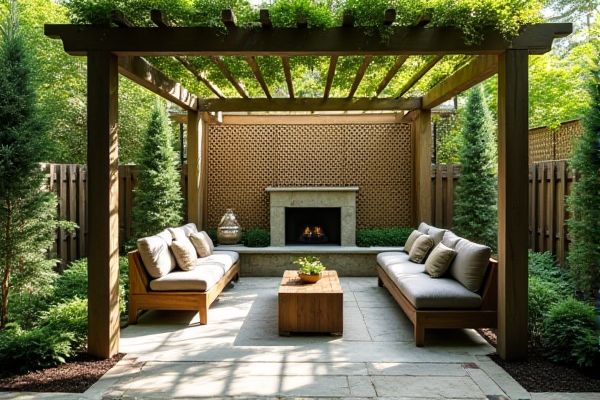
A trellis offers a decorative and structural framework ideal for supporting climbing plants, enhancing garden aesthetics, while a privacy screen focuses on blocking views to create secluded outdoor spaces. Understanding the differences can help you choose the best option to suit Your needs; explore the full article for detailed comparisons and tips.
Table of Comparison
| Feature | Trellis | Privacy Screen |
|---|---|---|
| Primary Function | Support climbing plants | Provide visual privacy |
| Material | Wood, metal, vinyl | Fabric, mesh, wood, metal |
| Design | Grid or lattice structure | Solid or semi-transparent panels |
| Installation | Mounted against wall or freestanding | Freestanding or mounted screens |
| Use Cases | Gardens, patios for plant growth | Balconies, patios for privacy and wind protection |
| Visual Barrier | Partial, depends on plants coverage | High, immediate visual obstruction |
| Durability | Varies by material, generally weather-resistant | Depends on material, designed for outdoor use |
| Maintenance | Periodic cleaning, plant care needed | Minimal, depends on material |
| Cost | Moderate | Varies from low to high |
Introduction to Trellis and Privacy Screens
Trellises and privacy screens serve as functional and decorative garden features, with trellises primarily supporting climbing plants like vines and roses, enhancing vertical growth and aesthetic appeal. Privacy screens, constructed from materials such as wood, metal, or synthetic panels, offer effective visual barriers for creating seclusion in outdoor spaces. Understanding the distinct purposes and materials of each helps you choose the right solution for enhancing your garden's privacy and design.
Key Differences Between Trellis and Privacy Screens
Trellises are designed primarily to support climbing plants, often featuring an open framework that promotes airflow and sunlight, whereas privacy screens provide solid or semi-solid barriers to block visibility and create secluded spaces. You will find trellises commonly used in gardens for decorative purposes, while privacy screens focus on enhancing outdoor privacy and noise reduction. Material choices also differ, with trellises frequently made from wood or metal lattice, and privacy screens utilizing wood panels, vinyl, or fabric for maximum coverage.
Purposes and Functions of Trellis Systems
Trellis systems primarily serve as structural supports for climbing plants, enhancing vertical garden aesthetics while maximizing space efficiency. They can also function to create defined outdoor areas or provide partial shade without fully obstructing views. Your garden benefits from the trellis' ability to blend decorative and functional uses, promoting healthy plant growth and improved landscape design.
Benefits of Installing Privacy Screens
Installing privacy screens enhances outdoor spaces by providing effective visual barriers that increase seclusion and reduce distractions from neighbors or passersby. Privacy screens also offer wind protection and can improve aesthetics with customizable designs that blend seamlessly into garden or patio environments. These benefits make privacy screens a practical and stylish solution for enhancing comfort and security in residential and commercial outdoor areas.
Material Options for Trellis vs Privacy Screens
Trellises are typically constructed from wood, vinyl, or metal, offering a sturdy framework ideal for climbing plants. Privacy screens often utilize materials such as bamboo, composite wood, fabric, or metal panels designed to provide effective visual barrier and wind blocking. Choosing between these depends on durability, aesthetic preferences, and the level of privacy required for outdoor spaces.
Design Versatility and Aesthetic Appeal
Trellises offer design versatility by supporting climbing plants and creating dynamic vertical gardens that enhance outdoor spaces with natural textures and greenery. Privacy screens provide a broader range of materials, including wood, metal, and composite options, allowing for sleek, modern, or rustic aesthetics tailored to specific design themes. Both solutions elevate aesthetic appeal while serving functional roles in defining outdoor areas and enhancing visual interest.
Installation Process and Maintenance Requirements
Installing a trellis typically involves securing a sturdy frame to a wall or setting posts in the ground, which may require moderate tools and effort, while privacy screens often come in pre-fabricated panels that are easier to install with basic hardware. Trellises demand regular maintenance such as painting or staining to prevent wood rot and inspections for structural integrity, whereas privacy screens made of vinyl or metal usually require minimal upkeep, primarily cleaning to preserve appearance. Your choice depends on how much time and effort you want to invest in installation and ongoing maintenance.
Cost Comparison: Trellis vs Privacy Screen
Trellises generally cost less upfront, with prices ranging from $50 to $200 depending on materials like wood, metal, or vinyl, while privacy screens often start around $100 and can exceed $300 for decorative or high-quality options. Trellises provide a durable, semi-permanent structure that can increase property value, whereas privacy screens offer flexible, portable solutions suited to temporary needs. Your choice depends on budget constraints and whether long-term investment or short-term versatility is more important.
Best Use Cases for Each Solution
Trellises are ideal for supporting climbing plants, creating vertical gardens, and enhancing outdoor aesthetics by providing structured plant growth and improved airflow. Privacy screens excel at blocking views, reducing noise, and offering immediate seclusion in outdoor spaces with materials like wood, metal, or fabric panels. Your choice depends on whether you prioritize plant support and natural beauty or functional privacy and screening.
Choosing the Right Option for Your Garden or Patio
Trellises offer vertical support for climbing plants, enhancing garden aesthetics while allowing sunlight and airflow, making them ideal for small spaces. Privacy screens create a solid barrier that blocks views and reduces noise, perfect for creating secluded outdoor areas on patios. Consider your garden's layout and desired level of privacy to choose the best option that complements Your outdoor decor and functional needs.
 homyna.com
homyna.com